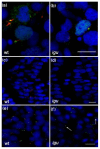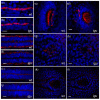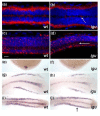Gli2a protein localization reveals a role for Iguana/DZIP1 in primary ciliogenesis and a dependence of Hedgehog signal transduction on primary cilia in the zebrafish
- PMID: 20487519
- PMCID: PMC2890509
- DOI: 10.1186/1741-7007-8-65
Gli2a protein localization reveals a role for Iguana/DZIP1 in primary ciliogenesis and a dependence of Hedgehog signal transduction on primary cilia in the zebrafish
Abstract
Background: In mammalian cells, the integrity of the primary cilium is critical for proper regulation of the Hedgehog (Hh) signal transduction pathway. Whether or not this dependence on the primary cilium is a universal feature of vertebrate Hedgehog signalling has remained contentious due, in part, to the apparent divergence of the intracellular transduction pathway between mammals and teleost fish.
Results: Here, using a functional Gli2-GFP fusion protein, we show that, as in mammals, the Gli2 transcription factor localizes to the primary cilia of cells in the zebrafish embryo and that this localization is modulated by the activity of the Hh pathway. Moreover, we show that the Igu/DZIP1protein, previously implicated in the modulation of Gli activity in zebrafish, also localizes to the primary cilium and is required for its proper formation.
Conclusion: Our findings demonstrate a conserved role of the primary cilium in mediating Hedgehog signalling activity across the vertebrate phylum and validate the use of the zebrafish as a representative model for the in vivo analysis of vertebrate Hedgehog signalling.
Figures







Comment in
-
Vertebrate Hedgehog signaling: cilia rule.BMC Biol. 2010 Jul 29;8:102. doi: 10.1186/1741-7007-8-102. BMC Biol. 2010. PMID: 20687907 Free PMC article.
Similar articles
-
The zebrafish iguana locus encodes Dzip1, a novel zinc-finger protein required for proper regulation of Hedgehog signaling.Development. 2004 Jun;131(11):2521-32. doi: 10.1242/dev.01059. Epub 2004 Apr 28. Development. 2004. PMID: 15115751
-
iguana encodes a novel zinc-finger protein with coiled-coil domains essential for Hedgehog signal transduction in the zebrafish embryo.Genes Dev. 2004 Jul 1;18(13):1565-76. doi: 10.1101/gad.296004. Epub 2004 Jun 15. Genes Dev. 2004. PMID: 15198976 Free PMC article.
-
Targeted mutation of the talpid3 gene in zebrafish reveals its conserved requirement for ciliogenesis and Hedgehog signalling across the vertebrates.Development. 2011 Nov;138(22):4969-78. doi: 10.1242/dev.070862. Development. 2011. PMID: 22028029 Free PMC article.
-
Regulatory mechanisms governing GLI proteins in hedgehog signaling.Anat Sci Int. 2025 Mar;100(2):143-154. doi: 10.1007/s12565-024-00814-1. Epub 2024 Nov 22. Anat Sci Int. 2025. PMID: 39576500 Review.
-
The primary cilium at the crossroads of mammalian hedgehog signaling.Curr Top Dev Biol. 2008;85:225-60. doi: 10.1016/S0070-2153(08)00809-0. Curr Top Dev Biol. 2008. PMID: 19147008 Free PMC article. Review.
Cited by
-
Vertebrate Hedgehog signaling: cilia rule.BMC Biol. 2010 Jul 29;8:102. doi: 10.1186/1741-7007-8-102. BMC Biol. 2010. PMID: 20687907 Free PMC article.
-
Primary cilia defects causing mitral valve prolapse.Sci Transl Med. 2019 May 22;11(493):eaax0290. doi: 10.1126/scitranslmed.aax0290. Sci Transl Med. 2019. PMID: 31118289 Free PMC article.
-
Ribonomic analysis of human DZIP1 reveals its involvement in ribonucleoprotein complexes and stress granules.BMC Mol Biol. 2014 Jul 3;15:12. doi: 10.1186/1471-2199-15-12. BMC Mol Biol. 2014. PMID: 24993635 Free PMC article.
-
DZIP1 Promotes Proliferation, Migration, and Invasion of Oral Squamous Carcinoma Through the GLI1/3 Pathway.Transl Oncol. 2019 Nov;12(11):1504-1515. doi: 10.1016/j.tranon.2019.07.005. Epub 2019 Aug 23. Transl Oncol. 2019. PMID: 31450126 Free PMC article.
-
Expanding horizons: ciliary proteins reach beyond cilia.Annu Rev Genet. 2013;47:353-76. doi: 10.1146/annurev-genet-111212-133243. Epub 2013 Sep 6. Annu Rev Genet. 2013. PMID: 24016188 Free PMC article. Review.
References
-
- McMahon AP, Ingham PW, Tabin CJ. Developmental roles and clinical significance of hedgehog signaling. Curr Top Dev Biol. 2003;53:1–114. full_text. - PubMed
Publication types
MeSH terms
Substances
Grants and funding
LinkOut - more resources
Full Text Sources
Molecular Biology Databases

